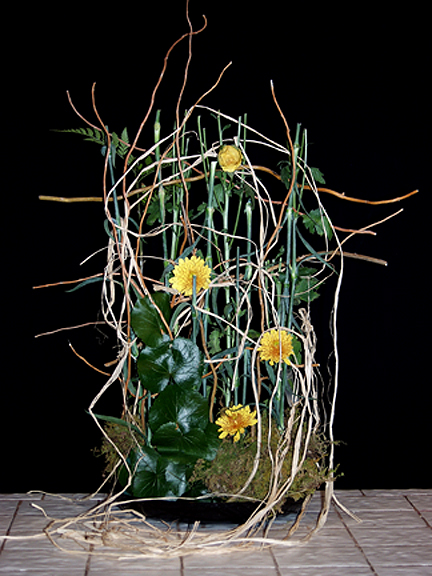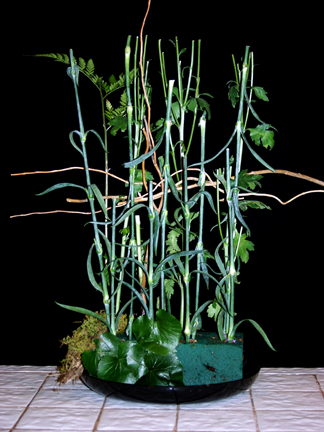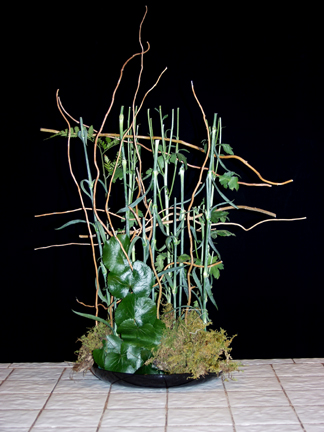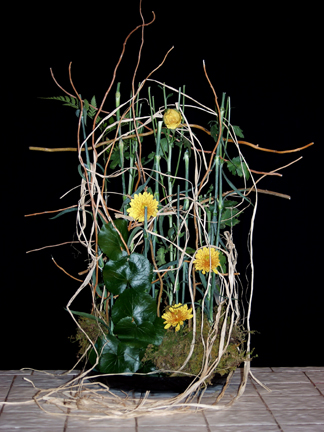|
Rittners School of Floral Design
in Boston Presents...
Abstraction (AKA: Fun With Stems!)
 Here is a design that will probably blow a few minds! Here is a design that will probably blow a few minds!
We call it "fun with stems!"
Will it be acceptable in every market or to every person? No. I don't think so. It is obviously not a telegraph delivery special marketed to the masses!
It is something very different. This design is for the same kind of person who enjoys looking at contemporary pictorial art.
It is for the person who can enjoy the
various textures and patterns, in say, a Jackson Pollock, or in a Mondrian work of art.
It is an abstraction. What differs is that this abstraction is not expressed in pictorial form,
but rather it is translated into the media of floral art.
Most people would agree that floral art can be used to express emotion, to convey love, romance, appreciation and even sympathy. Can floral art also serve
as a tool to facilitate pure visual exploration? Can it provide a mechanism to challenge our senses, and provide a means for the designer and viewer to appreciate pure form?
This design also points to another thing we take for granted in today's society. It is wonderful that we live in an era where one can go to a museum, and enjoy looking at abstract, contemporary things, yet
still appreciate impressionists, or paintings by Rembrandt and other artists. This is not to say that I am equating this floral design with any of
these famous artists' works, though obviously I found it a rather interesting piece, both to make and to observe. What I am saying here,
is that it is prettty neat to be living in an era that allows this kind of diverse freedom
in expression........It is wonderful that we have learned to approach and appreciate diverse expressions of art, on their own terms.......
We live in an era that accepts an incredible amount of diversity.....diversity in lifestyles, and in aesthetics. It is important that
as floral designers, we keep ourselves open to every kind of variation in floral art.
What You Will Need
- Utility container
- 1 block of foam
- Stems
- Curly Willow
- A few flowers
- Galax leaves
- Moss
- Water tubes
 We start this design
by placing a block of foam into a container. The base that we
are using is a utility dish, meaning an inexpensive container. However,
you can use any container that you'd like. This design starts where most floral art ends.
Usually when we finish stylizing a piece of floral art, we clean off the table and discard any leftover stems.
In this case, we rescue the stems
and use them to create several rows, one towards the back of the foam,and the other towards
the front. Most of the stems used in this design are pompon stems and carnation stems. We also
used one or two stems of baker fern. If you look carefully at the picture, I think you'll be able
to discern two rows. We start this design
by placing a block of foam into a container. The base that we
are using is a utility dish, meaning an inexpensive container. However,
you can use any container that you'd like. This design starts where most floral art ends.
Usually when we finish stylizing a piece of floral art, we clean off the table and discard any leftover stems.
In this case, we rescue the stems
and use them to create several rows, one towards the back of the foam,and the other towards
the front. Most of the stems used in this design are pompon stems and carnation stems. We also
used one or two stems of baker fern. If you look carefully at the picture, I think you'll be able
to discern two rows.
Next we start to weave a few stems of curly willow, horizontally through the arrangement. Secure carefully with wire.
 After placing the stems vertically, we are weaving curly willow horizontally though the design.
Notice some pieces up higher, some down lower. We are not concerned about the willow being perfectly
parallel with the ground. Notice that the pieces are deliberately angled at a slight angle upwards and downwards.
In this way, the design is not rendered too predictable.
After placing the stems vertically, we are weaving curly willow horizontally though the design.
Notice some pieces up higher, some down lower. We are not concerned about the willow being perfectly
parallel with the ground. Notice that the pieces are deliberately angled at a slight angle upwards and downwards.
In this way, the design is not rendered too predictable.
A few galax leaves are placed on the left side of the design. We want to get them into
the foam base if possible. We start inserting the moss onto the foam mechanic. In this way we are designing, yet still covering our mechanics. Just because
a design is a little way out in no way excuses faulty or sloppy mechanics.
The overall effect, is rather complex. Contrast of pom, carnation and willow steming coupled
with pom and galax foliage make this unit visually complex.
The design is nice
but rather plain looking, so let's jazz it up!!!
It needs a few flowers before the end of the day, to draw attention and to really create maximum impact!
 The flowers are placed into water tubes which are then tied into the matrix.
Raffia is then interwoven throughout the framework. This helps to provide greater fluidity,
decrease visual rigidity, and to give contrast in color,form and material.
Nice rhythmic flow here. Note the fusion of both positive and negative space.
The flowers are placed into water tubes which are then tied into the matrix.
Raffia is then interwoven throughout the framework. This helps to provide greater fluidity,
decrease visual rigidity, and to give contrast in color,form and material.
Nice rhythmic flow here. Note the fusion of both positive and negative space.
No. This is probably not the kind of arrangement that a fellow will give to his best girl as a romantic
statement. It does not have to be.
It does, however, challenge us on many levels.
It challenges us to examine form in floral art.
It challenges us to consider how open minded we are in our aesthetic choices.
It challenges us to reconsider the function and purpose of art in general and floral art in particular.
We hope that you really enjoyed this brief floral design lesson. At
Rittners Floral School in Boston we provide
floral design instruction that includes a wide range of different
styles and techniques. Our students learn both classical favorites and cutting edge styles.
Please come and take one of our hands-on
workshop programs!!
Rittners Floral Education Center
returns you to our Floral Education Center.
|